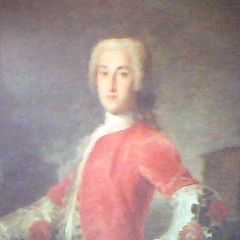George Lewis Coke
| George Lewis Coke | |
|---|---|
|
portrait by Pompeo Batoni | |
| Born |
1715[1] Derbyshire |
| Died |
1715 (aged -37–-36) prob. Melbourne, Derbyshire |
| Education | Oxford University |
| Occupation | Gentleman |
| Spouse(s) | no |
| Children | no |
| Parent(s) | Thomas Coke |
George Lewis Coke (1715–1751) inherited his father’s property at Melbourne, Derbyshire. Some accounts say he returned from his Grand Tour to complete his father’s work on Melbourne Hall. On his death, the property went to his sister who was to become grandmother to William Lamb, 2nd Viscount Melbourne, the Victorian Prime Minister.
Biography
George Lewis Coke was born in 1715 to Thomas Coke and his wife Mary (née Hale). His father had been Vice-Chamberlain of the Household to Queen Mary and George I.[2] Thomas Coke had also been Teller of the Receipt of the Exchequer briefly in 1704.
His father died when he was twelve and he was taken care of by his uncle, John Coke, in London. He attended Oxford University in 1732 and property at Kings Newton was purchased for him by his uncle.[3]
When Coke was nineteen he embarked on the traditional Grand Tour of Europe, despite being appointed Surveyor-General of His Majesty's Customs two years before when he was just 17.[1] In the first year he visited Paris and ?? after staying over the winter in Montpelier, he visited Rome, Venice.... Whilst in Italy he had his portrait made by the Italian painter, Pompeo Batoni - who made a good living from young English aristocrats. Like other Grand Tour portraits, Coke appears amongst antiquities. In this case the Coliseum is in the background of Batoni’s composition.
According to some sources
Coke returned from abroad and unusually he came back with a “companion and tutor” known as John Lewis Pasteur.
Between 1742 and 1745, Coke hired William Smith to remodel the gardens of Melbourne Hall which together with rebuilding the front and east wing completed the plans of his father who had died prematurely.
In 1745 a key event happened in British History when Bonnie Prince Charlie travelled with Scottish supporters south towards London to claim the throne of England. The troops made it as far as Swarkestone Bridge which takes the road between Derby and Melbourne over the River Trent. A source says, the Deputy Lieutenant and the monarch’s representative in the county in 1745 was George Lewis Coke.[4]
Coke died without any children and his lands passed to his sister, Charlotte, who had married the family lawyer. Coke’s companion lived until the year 1793 after marrying and having three children in England. Pasteur paid the Hearth Tax on the hall over twenty years after Coke’s death in 1777.
Afterwards and alternatively
In 1860, the fabric of Melbourne church was restored and this involved the removal of “hundreds of skulls” and the first coffin to be removed was that of George Lewis Coke which was unusual in shape. This was recorded by the local historian John Joseph Briggs who also noted the story about his valet, John Lewis Pasteur. According to Briggs, Coke had returned from abroad in the coffin, 109 years before, with Pasteur as velet. It was Pasteur who went on to be a shepherd (‘’Pasteur in French’’) in Bredon.[5] Briggs indicates that Coke never returned alive from his foreign tour and that his coffin was of "foreign" construction. Others agree with Briggs and say that “J.L.Pasteur” set out on the journey with him.[3]
References
- ↑ 1.0 1.1 The History of Melbourne Hall
- ↑ Thomas Coke served from 1706 to 1727
- ↑ 3.0 3.1 Coke of Trusley
- ↑ "The Owners of Melbourne Hall, Howard Usher,, 1993
- ↑ . ["The History of Melbourne in the county of Derby, including Biographical Notices of the Coke, Melbourne and Hardinge Families", by John Joseph Briggs, Bemrose, 1852.]
